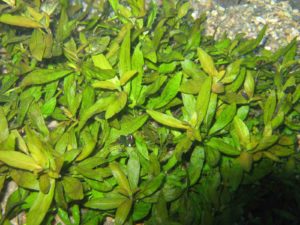Non-Native

Hygrophila polysperma
More Info & Photos of Hygrophila
Non-Herbicide Management Options
1. Physical Management Options
Hygrophila can be removed by raking or seining it from the pond, but it will re-establish from any remaining fragments and roots.
Non-toxic dyes or colorants prevent or reduce aquatic plant growth by limiting sunlight penetration, similar to fertilization. However, dyes do not enhance the natural food chain and will suppress the natural food chain of the pond.
Some examples of non-toxic dyes and other products include but are not limited to:
Many types of mechanical removal devices are available that cut or chop up aquatic weeds. It is important to remember that many submerged plants regrow from fragments, so removal of cut fragments may be necessary to keep from spreading the unwanted plant.
Companies that make cutters and rakes include but are not limited to:
2. Biological Management Options
At this time, there are no known biological controls for hygrophila.
Herbicide Control Options
Always read the product label for directions and precautions, as the label is the law. Click on the name of the product to see the label. Read the label for specific water use restrictions.
The only active ingredient that has been successful in treating hygrophila is:
- Flumioxazin (Rated: Good)
- Imazapyr
- Triclopyr
These rating are based upon the U.S. Army Corps of Engineers aquatic herbicide trials.
1) Flumioxazin
Flumioxazin is a water dispensable granule that is to be sprayed or injected after mixing. It is a broad spectrum, contact herbicide. Contact herbicides act quickly. Flumioxazin should be applied to actively growing plants and a surfactant (a substance that reduces water tension) will be needed if the herbicide is applied to foliage of floating or emergent plants. Water pH needs to be below 8.5 or flumioxazin will rapidly degrade and lose effectiveness.
Common trade and product names include but are not limited to:
2) Imazapyr
The active ingredient, imazapyr, inhibits the plant enzyme AHAS (acetohydroxyaced synthase). Habitat is a systemic herbicide that is effective on post-emergent floating and emergent aquatic vegetation. Imazapyr is effective at low-volume rates and does not contain heavy metals, organochlorides or phosphates, making it safe to humans and livestock. Habitat requires the use of a spray adjutant when applying on post-emergent vegetation.
Common trade or product names include but are not limited to:
3) Triclopyr
Liquid triclopyr formulation is a selective broadleaf, systemic herbicide. Systemic herbicides are absorbed and move within the plant to the site of action. Systemic herbicides tend to act more slowly than contact herbicides. An aquatically registered surfactant (see the label) will improve the effectiveness of triclopyr.
Common trade or product names include but are not limited to:
Precautions
One danger with any chemical control method is the chance of an oxygen depletion after the treatment caused by the decomposition of the dead plant material. Oxygen depletion can kill fish in the pond. If the pond is heavily infested with weeds, it may be possible (depending on the herbicide chosen) to treat the pond in sections and let each section decompose for about two weeks before treating another section. Aeration, particularly at night, for several days after treatment may help avoid an oxygen depletion.
One common problem in using aquatic herbicides is determining area and/or volume of the pond or area to be treated. To assist you with these determinations see SRAC #103 Calculating Area and Volume of Ponds and Tanks.
Many aquatically registered herbicides have water use restrictions. For General Water Use Restrictions click here.
To see the labels for these products click on the name. Always read and follow all label directions. Check label for specific water use restrictions.
Cultivation Options
This plant is not native to North America and should not be introduced into new water bodies and should be treated with herbicide when present.
Questions?
If you need assistance, contact the Ag & Natural Resources agent in your county or hire a professional.